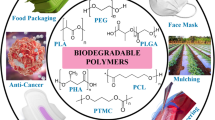Abstract
Poly(methyl methacrylate) (PMMA) microspheres were synthesized through visible light–induced photopolymerization of methyl methacrylate (MMA). 2,4,6-Trimethylbenzoyldipenylphosphine oxide (TPO), polyvinylpyrrolidone (PVP), and light-emitting diodes (LEDs) were used as the photoinitiator, stabilizer, and light source, respectively. No other additive was involved. The effect of LEDs, TPO, and PVP was discussed. Results showed that PMMA microspheres with the size of 0.5–0.8 μm could be obtained when LED@385 nm was the light source, and the content of TPO and PVP was 2 wt% and 30 wt% of MMA. Moreover, the possible formation pathway of PMMA microspheres was proposed based on the investigation of reaction time and addition method of PVP.

Graphical abstract










Similar content being viewed by others
References
Xiao XC, Chu LY, Chen WM, Wang S, Xie R (2004) Preparation of submicrometer-sized monodispersed thermoresponsive core-shell hydrogel microspheres. Langmuir. 20:5247–5253. https://doi.org/10.1021/la036230j
Louzao I, Jan CM (2013) Permeability effects on the efficiency of antioxidant nanoreactors. Biomacromolecules. 14:2364–2372. https://doi.org/10.1021/bm400493b
Liu T, Hu JM, Jin ZY, Jin F, Liu SY (2013) Two-photon ratiometric fluorescent mapping of intracellular transport pathways of pH-responsive block copolymer micellar nanocarriers. Adv Healthc Mater. https://doi.org/10.1002/adhm.201200436
Bandura D, Baranov V, Mitchell A, Winnik (2009) Lanthanide-Containing Polymer Microspheres by Multiple-Stage Dispersion Polymerization for Highly Multiplexed Bioassays. Jacs Articles 131:15276-15283. https://doi.org/10.1021/ja9052009
Wang Z, Matthijs CM (2012) Polymersome colloidosomes for enzyme catalysis in a biphasic system. Biocatalytic Nanoreactors 51:10746–10750. https://doi.org/10.1002/anie.201206555
Qiao HM (2015) Preparation of monodisperse porous polymer microspheres and their antiphase chromatographic application. Fine Chemicals 32(7):721–725. https://doi.org/10.13550/j.jxhg.2015.07.001
Tan JB, Zhao GY, Zeng ZH, Mitchell MA (2015) PMMA microspheres with embedded lanthanide nanoparticles by photoinitiated dispersion polymerization with a carboxy-functional macro-RAFT agent. Macromolecules. 48:3629–3640. https://doi.org/10.1021/acs.macromol.5b00688
Nie J, Li Q, Zhu XQ (2018) CN 108341966 A 20180731
Shim SE, Jung H, Lee HJ, Biswas J, Choe S (2003) Living radical dispersion photopolymerization of styrene by a reversible addition-fragmentation chain transfer (RAFT) agent. Polymer. 44:5563–5572. https://doi.org/10.1016/S0032-3861(03)00632-3
Chen J, Zeng ZH, Yang JW, Chen YL (2008) Photoinitiated dispersion polymerization of methyl methacrylate: A quick approach to prepare polymer microspheres with narrow size distribution. J Polym Sci A Polym Chem 46:1329–1338. https://doi.org/10.1002/pola.22473
Tan JB, Peng YC, Liu DD, Huang CD, Yu MG, Jiang D, Zhang L (2016) Facile preparation of monodisperse poly(2-hydroxyethyl acrylate)-grafted poly(methyl methacrylate) microspheres via photoinitiated RAFT dispersion polymerization. Macromol Chem Phys. https://doi.org/10.1002/macp.201600176
Tan JB, Xin R, Wu XH, Deng HC, Yang JW, Zeng ZH (2012) Photoinitiated RAFT dispersion polymerization: A straightforward approach toward highly monodisperse functional microspheres. Macromolecules. 45:8790–8795. https://doi.org/10.1021/ma301799r
Xie CB, Wang ZM, Liu YY, Song L, Liu L, Wang ZW, Yu Q (2019) A novel acyl phosphine compound as difunctional photoinitiator for free radical polymerization. Prog Org Coat 135:34–40. https://doi.org/10.1016/j.porgcoat.2019.05.021
Liu YY, Wang TT, Xie CB, Tian XJ, Song L, Liu L, Wang ZW, Yu Q (2020) Naphthyl-based acylphosphine oxide photoinitiators with high effiency and low migration[J]. Prog Org Coat 142:105603. https://doi.org/10.1016/j.porgcoat.2020.105603
Pongprueksa P, Miletic V, Janssens H (2014) Degree of conversion and monomer elution of CQ/amine and TPO adhesives. Dent Mater 30(6):695–701. https://doi.org/10.1016/j.dental.2014.03.007
Liu Y, Wang Y (2013) Effect of proanthocyanidins and photo-initiators on photo-polymerization of a dental adhesive. J Dent 41:71–79. https://doi.org/10.1016/j.jdent.2012.10.006
Dragica M, Miroslav DD, Milos M (2016) Effects of a low-shrinkage methacrylate monomer and monoacylphosphine oxide photoinitiator on curing efficiency and mechanical properties of experimental resin-based composites. Mater Sci Eng C 58:487–494. https://doi.org/10.1016/j.msec.2015.08.054
Struzynska-Piron I, Loccufier J, Vanmaele L, Ivo FJ (2013) Synthesis of solvent stable polymeric membranes via UV depth-curing. Chem Commun 49:11494–11496. https://doi.org/10.1039/c3cc46795c
Fritsch J, Mansfeld D, Mehring M, Wursche R, Grothe J, Kaskel S (2011) Refractive index tuning of highly transparent bismuth containing polymer composites. Polymer. 52:3263–3268. https://doi.org/10.1016/j.polymer.2011.05.046
Sumiyoshi T, Schnabel W (1985) On the photolysis of acylphosphine oxides: 1. laser flash photolysis studies with 2,4,6-trimethylbenzoyldiphenylphosphine oxide. Polymer. 26:141–146
Sumiyoshia T, Schnabel W (1985) On the reactivity of phosphonyl radicals towards olefinic compounds. Mukromol Chem 186:1811–1823
Funding
This work was funded by the National Natural Science Foundation of China (Grant Nos. 21103099, 21676285, and 21306214), Basic Research Projects in Science and Technology Program of Qingdao (13-1-4-242-jch), Qingdao Indigenous Innovation Program (No. 15-9-1-76-jch), and Research Foundation of Qingdao Fusilin Chemical Science &Technology Co., Ltd. (FSL-RF 2016).
Author information
Authors and Affiliations
Corresponding authors
Ethics declarations
Conflict of interest
The authors declare that they have no conflicts of interest.
Additional information
Publisher’s note
Springer Nature remains neutral with regard to jurisdictional claims in published maps and institutional affiliations.
Chuanbao Xie and Kangwei Leng shared as co-first author of this article
Rights and permissions
About this article
Cite this article
Xie, C., Leng, K., Sheng, J. et al. Preparation of poly(methyl methacrylate) microspheres via photopolymerization initiated by LED light source. Colloid Polym Sci 298, 1285–1291 (2020). https://doi.org/10.1007/s00396-020-04694-5
Received:
Revised:
Accepted:
Published:
Issue Date:
DOI: https://doi.org/10.1007/s00396-020-04694-5




